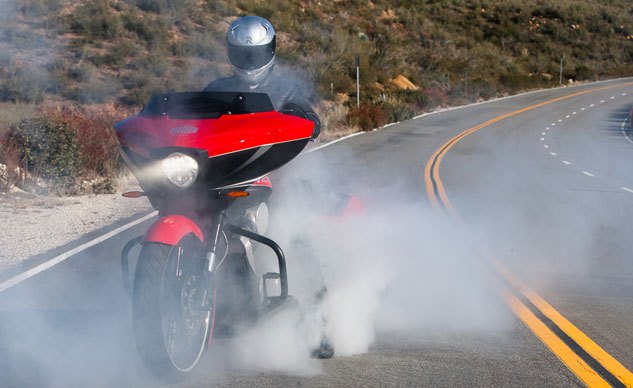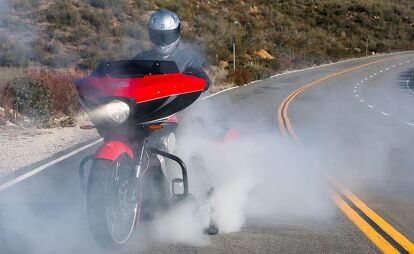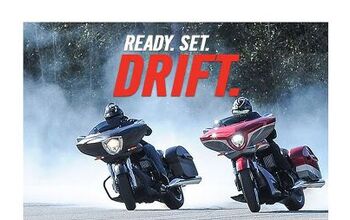Lloydz Motor Workz Supercharged Victory Cross Country Review

Lab Test Animal
What we have here is a genetically altered motorcycle that used to be a 2012 Victory Cross Country. Given its 21-inch front wheel and saddlebag speakers, it can be seen as a transitionary mutation between the CC and the recently released Magnum. However, the characteristic we’re here to address can be found wrapped around the engine. (After all we’ve reviewed the 2015 Victory Magnum, in case you’re interested in the whole big front wheel and the kickin’ stereo thing.)
When it came time to power this exploratory Cross Country, Victory’s Accessory Department turned to Lloydz Motor Workz, who astute readers may remember being mentioned in our 2014 International Motorcycle Shows Long Beach Wrap-Up Report – but we’re getting ahead of ourselves. The original plan called for a turbocharged Cross Country. Lloyd Greer, the Lloyd behind Lloydz Motor Workz, said he initially turned down the project because, while they make decent power, turbochargers are ugly and almost impossible to hide on a bike with no bodywork. After some thought, he called Victory back and suggested a supercharger instead.
Time Crunch
Like many projects, this one got off the ground and was already under the gun from the moment the Cross Country arrived at the shop. Although Greer was supposed to begin work in April, he didn’t receive the bike until June, leaving him with just 34 days to get the ProCharger grafted to the bike and running. Since it was destined to be revealed at the Victory Dealer Show, the kit should look nice, too. Other than the request for a satin finish on the components, Victory’s only stipulation was that the bike’s frame could not be altered – which makes sense in a whole bunch of ways.
Because of the limited time, Greer ended up modifying the air cleaner housing and plenum ProCharger sells for Harley Big Twins. The intercooler was dropped next to the lower left side of the engine with the aftermarket coils mounted directly behind the intercooler.
Getting the ProCharger B1 Supercharger to fit was a challenge. Once the location formerly taken by the CC’s battery was selected, the supercharger’s outlet needed to be cut off and replaced with a 90° elbow. Space is so tight that the intake lives right behind the heat wrapped exhaust header. There’s not even enough room for a finger between the exhaust and the intake mouth. We have to guess that, at speed, so much air flows by the header that it won’t dramatically affect the intake air temperature.
The pulley system powering the supercharger is a work of art. Leaving the belt exposed on the top, allows the rider to see it turning when idling at a stoplight. The machined-from-billet aluminum plate that holds the assembly to the right side of the engine is too nice a part to be covered up by the floorboard and rear brake (not to mention the rider’s foot), but that’s the way it is.
One of the nice things about superchargers, when compared to turbos, is that they don’t require the extensive exhaust modifications. Since the supercharger is mechanically connected to the engine and not powered by the flow of exhaust gasses, any old performance exhaust that can handle the volume of output will do. Being a Victory factory project bike, no one should be surprised that a Tri-Oval Stage 1 Exhaust out of the company’s accessory catalog graces the Cross Country.
Delivery Challenges
After spending more than 400 hours – almost 17 full days – actively working on the bike, Greer still needed to deliver the bike in the 34 allotted days. (Anyone who’s ever spent any time with builders knows that this kind of deadline time crunch is common.) So, he decided to put the Victory in the back of his Ford F250 diesel, which should’ve allowed him to make better time than with a trailer. Only, nobody told the truck.
Crossing the Ohio state line after the end of business hours for the day, the truck’s alternator decided to expire. This put Greer and his two driving companions in a bit of a pickle. If they stopped the engine, they were done until they could buy a new alternator. If the battery died – which it eventually would since it was being drained by running the engine’s electronics – they would be stranded. The solution to the problem was to stop at a truck stop, buy an extension cord, and wire the bike’s charging system to the truck’s. The extension cord ran through the cab’s split rear window, out the passenger window, under the hood, and to the battery. All non-essential electrical components on the bike and truck were disconnected, and the bike was started.
The supercharged Victory Cross Country idled in the truck bed for the 11 hours it took to drive from that truck stop in Ohio to Eau Claire, Wisconsin, where they finally found a Ford dealership that was open. To keep the bike’s engine cool all that time, they kept the truck windows open, allowing air to flow through the truck and out the split rear window where the bike was idling. With a new alternator installed, the Big Twin got to rest.
Thanks to their creative thinking, the Cross Country made it to Victory’s Wyoming, Minnesota production facility in time to be packed on a truck and shipped with the rest of the bikes needed for the Victory Dealer’s Show in Las Vegas. After that event, with the exception of some time spent back at Lloydz Motor Workz for some fine-tuning, the bike has been displayed to the public at various rallies and shows – which is where MO discovered the bike and arranged to get our grubby mitts on it.
Life in the Real World
This supercharged Cross-Country is remarkably cold-blooded, refusing to start without a slight twist of the throttle. The additional load on the starter motor can be heard when attempting to crank the engine over for the first time with the compression strokes slowing down the turnover dramatically. When the engine fires, though, the additional mechanical processes are immediately apparent. The sound of the belt on the pulleys mixes with the mechanical noise of the ProCharger and the intake sucking sound playing in the background. Roll on the throttle, and the music picks up its tempo with the hearty bass note from the Victory Tri-Oval Stage 1 Exhaust announcing its presence.
What you’ll also notice is how incredibly rich the bike runs at idle. While the engine delivers a nice, lumpy cadence at idle – once it’s warm – the mixture remains rich enough to notice with the nose. Get a little carried away, rapping on the throttle while waiting at a stoplight, and your eyes may burn from the hydrocarbons. Greer says the richness at idle is intentional. A rich intake mixture cools the combustion chamber, reducing detonation and helping preserve engine durability.
Then the light turns green, and you pull away expecting a beast. Instead, you get some pretty benign acceleration. This is the crux of this supercharged engine: Ride it like a stock bike, and it’ll feel unexpectedly tame. While the bottom-end torque feels like a well-endowed V-Twin – stouter than its 106 cubic inches – you have to give big doses of throttle while spinning up to the rev limit before you really experience the acceleration this supercharged engine can mete out. To deliver the maximum benefit of all that top-end power, Greer raised the rev-limit to 6400 rpm!
Smokey Burnout Editor, Troy Siahaan, summed the experience up best with: “For someone used to high-horsepower sportbikes, the supercharged Victory was initially underwhelming. However, I learned that the beauty of the forced induction occurs the higher in the revs you reach. Big Twins are known for their torque, but fall flat quickly once they start to spin faster and faster. With the supercharger, you retain the bottom-end torque, but also get the top-end rush to boot. It’s the best of both worlds!”
“Unlike the boost from a turbo, which delivers a robust hit only after pressure ramps up, the supercharged setup by Lloydz simply delivers more power everywhere, almost as if a third cylinder had somehow been bolted on. While the power curve hasn’t been radically altered, the extra grunt on tap dramatically shortens the time between gearshifts – I can’t recall hitting a Victory’s rev limiter until I rode this one,” agreed International Racetrack Editor, Kevin Duke.
Or, as I exclaimed to Troy at a stop sign before blasting away en-route to our photo shoot location: “This bike is a blast when you ride it like a complete dickhead!”
When discussing the power delivery with Greer, he concurred, saying that shifting before redline was leaving horsepower on the table for no good reason: “People don’t grasp how much power is there. A lot of times, they’re shifting early, too. When there’s a 40 hp difference in 1,000 rpm and you shift 1,000 rpm too soon, it makes a big difference.”
Some of you may be wondering why a builder would let us ride a bike that clearly needed some refinement. After all, we’re gonna write about it whether we like it or not. The reason is simple: Greer has moved on. This bike was his test mule for the supercharger set up, and he’s taken what he learned from this bike and refined it.
The ProCharger kit that Lloydz Motor Workz sells for $6,200 is dramatically different from the system fitted to our test mule. The intercooler now hangs off the left side of the engine where the air cleaner used to live. In fact, the intercooler and the plenum are now one piece which is held in place by nylon cones and four O-rings. Instead of being bolted on to the engine, the assembly is pressed into place by the frame when the engine is bolted in position. The air cleaner has moved to the intake of the supercharger where it is mounted on the end of a 4-in. extension that moves the intake out from behind the exhaust header and into the clear air where the intercooler used to be. The EFI has been cleaned up, and the battery has been located in the left saddlebag.
The kit comes in three finishes: satin (like the bike we rode), polished chrome or black (the best seller).
Our takeaway from our time with this beast is how refined the power delivery is at partial throttle. Get past the engine’s cold bloodedness, and the power delivery is factory smooth with no hiccups. When the throttle is cranked to the stops, you better be holding on – particularly when the tach needle moves above 4500.
Out on a winding road, the fun is on the straights as you accelerate through the gears. However, the rider must always remain cognizant that this engine is capable of writing checks that the chassis’ ground clearance and the big front hoop’s steering are disinclined to cash. Around town, power delivery allows you to open a can of whoop-ass on unsuspecting riders, which is always a prescription for fun.
Our time aboard the test mule not only impressed us with the power output, but also shocked us with the fuel consumption. Just riding around town or on highway jaunts without really flexing the engine’s muscles delivered 29.2 mpg. A day out in the canyons with the throttle pulled to the stop whenever possible dropped the mileage to a surprising 19.3 mpg! While we’re suspect that the upgrades to the EFI in the shipping kit would improve the mileage somewhat, this modification is clearly for the type of rider who wants to help us consume the planet’s fossil fuel as quickly as possible so that we can go on and develop the next motorcycle power source to a similar level of refinement.
When all the smoke from the rear tire disperses and the engine idles expectantly between our legs as the throttle tempts us to twist it again, we can’t think of a better way to void a Freedom 106’s warranty.

Like most of the best happenings in his life, Evans stumbled into his motojournalism career. While on his way to a planned life in academia, he applied for a job at a motorcycle magazine, thinking he’d get the opportunity to write some freelance articles. Instead, he was offered a full-time job in which he discovered he could actually get paid to ride other people’s motorcycles – and he’s never looked back. Over the 25 years he’s been in the motorcycle industry, Evans has written two books, 101 Sportbike Performance Projects and How to Modify Your Metric Cruiser, and has ridden just about every production motorcycle manufactured. Evans has a deep love of motorcycles and believes they are a force for good in the world.
More by Evans Brasfield























































Comments
Join the conversation
lloyyd you left out the part of the build where I got the rest of the bike together in 4 days and it was driven to Vegas from the factory in
Greer says the richness at idle is intentional